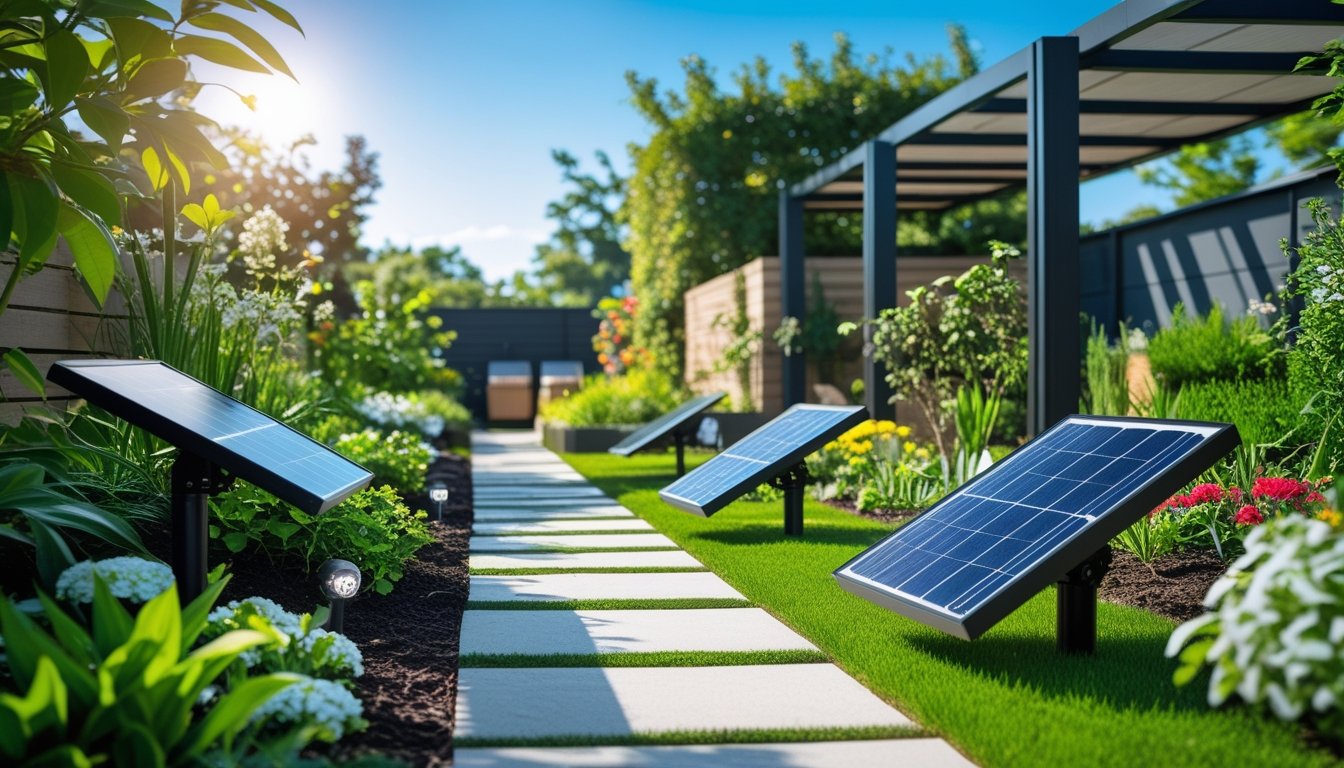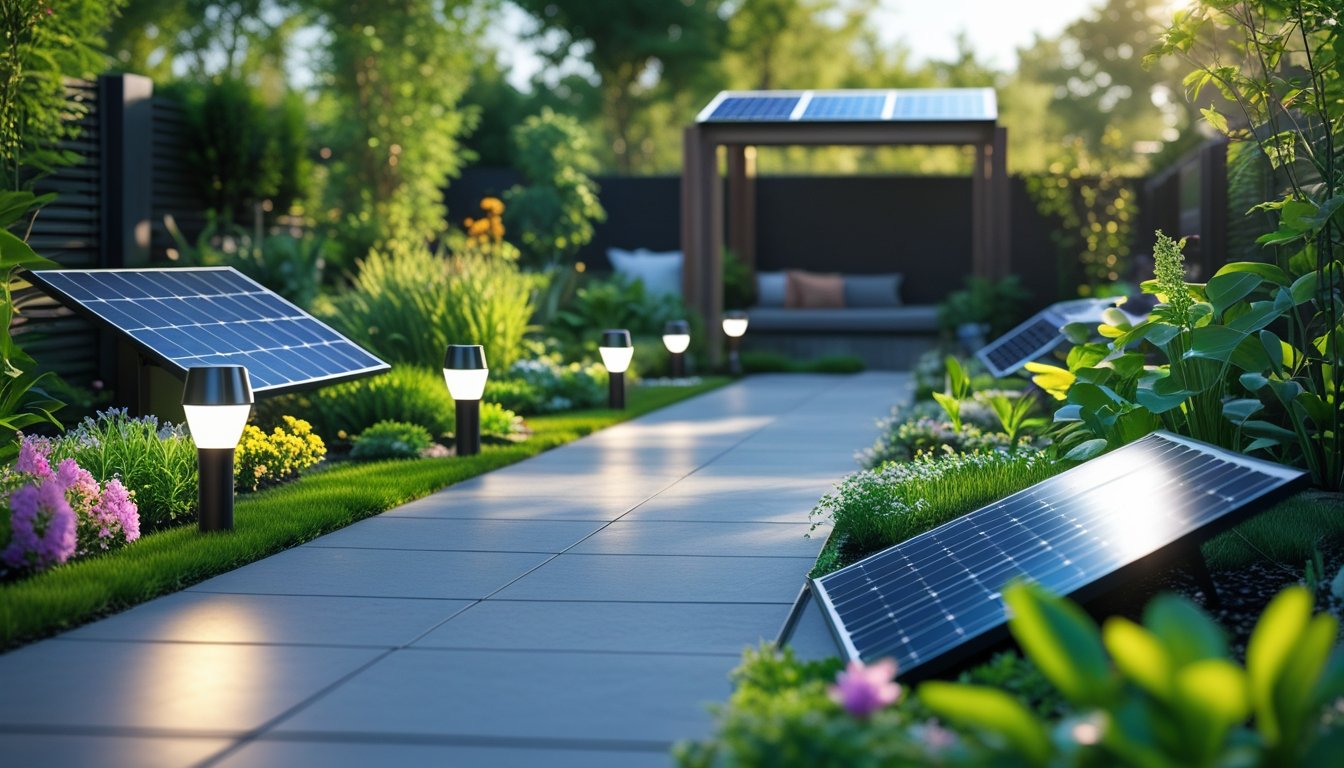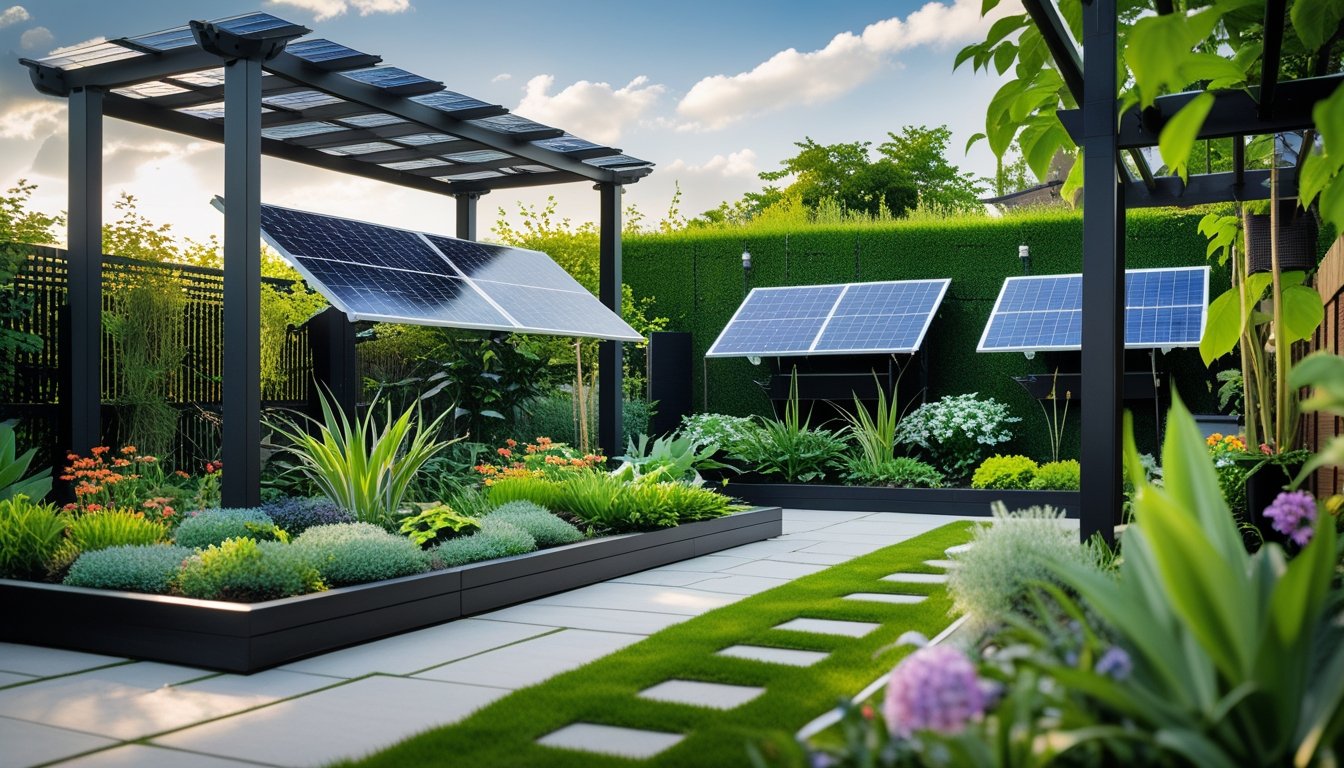Late updated: 19 Aug 2025 15:08
Written by: James Whitaker
Integrating Solar Energy Into Your Garden Design: A Sustainable Approach
Integrating solar energy into our garden design is an innovative way to create an eco-friendly and efficient outdoor space. By adopting solar technology, we can reduce electricity costs while enhancing the aesthetic appeal and functionality of our gardens. This approach not only diminishes our carbon footprint but also offers the flexibility to use solar-powered lights, water features, and irrigation systems to create a sustainable garden environment.

As advocates of environmental sustainability, we understand the importance of harmonising technology with nature. Solar panels can seamlessly blend into our garden landscapes, providing renewable energy without compromising beauty. With numerous practical options available, from solar lights to solar fountains, incorporating these solutions enhances our garden's charm.
Solar energy offers immense potential with minimal environmental impact. Emphasising both beauty and efficiency, our sustainable gardens become sanctuaries that reflect our commitment to green living. Exploring diverse solar options will allow us to optimise energy use and maintain harmony with nature.
Key Takeaways
- Solar integration reduces electricity costs and carbon footprint.
- Renewable energy solutions blend technology with garden aesthetics.
- Sustainable gardens showcase commitment to eco-friendly living.
Integrating Solar Energy Into Your Garden Design

Incorporating solar energy into garden design not only supports environmental sustainability but also reduces electricity costs. Solar technology offers aesthetic solutions that enhance the beauty of outdoor spaces without increasing the carbon footprint.
Key Benefits of Solar Energy in the Garden
Solar energy provides a clean power source for garden elements, significantly lowering the carbon footprint. This renewable energy source supports environmental sustainability. By using solar, we can power lighting, water features, and irrigation systems. This reduces reliance on traditional electricity sources. The result is lower energy bills and more environmentally-friendly gardening practices. Additionally, solar technology adds unique, aesthetic features to garden landscapes, enhancing their beauty.
Types of Solar-Powered Features for Gardens
Solar panels can be integrated into various garden elements. Solar-powered lights can illuminate pathways, creating a welcoming atmosphere. Fountains and water features can be run on solar energy, adding a soothing element that enhances relaxation spaces. Irrigation systems benefit from solar power by ensuring efficient water management without needing electrical connections. These applications not only use sustainable energy but contribute to the overall harmony of natural spaces. The diversity of options allows us to tailor designs that meet both functional and aesthetic needs.
Assessing Site Conditions for Solar Integration
Before integrating solar technologies, we must evaluate site conditions carefully. Sunlight exposure is critical; areas with direct sunlight are ideal for placing solar panels. We should consider the angle and position to maximise energy capture. Nearby structures or trees may cast shadows, impacting efficiency. Local weather conditions like cloud cover and precipitation levels should also be taken into account. By assessing these factors, we can optimise the placement and effectiveness of solar installations, ensuring they deliver maximum benefit throughout seasons.
Selecting and Implementing Solar Solutions for Outdoor Spaces

Incorporating solar solutions into our garden spaces enhances both functionality and sustainability. We can enjoy reduced energy costs while improving the aesthetics and environmental footprint of our outdoor areas.
Choosing the Right Solar Panels and Equipment
Selecting the appropriate solar panels is crucial. We must consider factors such as efficiency, size, and power output to match our energy needs. Panels come in various types, including monocrystalline, polycrystalline, and thin-film, each with its own benefits.
Monocrystalline panels offer high efficiency and compact designs. Polycrystalline panels, although slightly less efficient, are more affordable. Thin-film, known for flexibility and lightweight, suits specific installations.
Equipment such as inverters and battery storage should not be overlooked. They ensure energy conversion and availability during non-sunny periods. Quality and warranty considerations are vital here to ensure the longevity of our solar investments.
Aesthetic Integration with Garden Landscapes
The integration of solar technology should harmonise with our garden aesthetics. Panels and equipment can be seamlessly incorporated into designs without disrupting natural beauty.
Camouflaging techniques such as placing panels on pergolas or integrating them into garden fences help maintain aesthetic appeal. Additionally, solar garden lights can be artistically placed to highlight landscaping features while providing functionality.
We should explore innovative materials and designs that blend into our outdoor spaces. Choosing the right plants and garden structures can also help to naturally conceal solar systems, ensuring they remain both visually appealing and effective.
Innovative Solar Lighting Options
Solar lighting options have advanced considerably. They offer versatile and sustainable solutions for illuminating outdoor spaces. From pathways to garden features, a variety of solar-powered lights are available to suit different needs.
We should consider motion sensor lights for pathways and decorative lanterns for ambient lighting. Advanced options include colour-changing lights and programmable systems that can be tailored for specific moods or events.
The placement of lights can dramatically affect evening aesthetics. By positioning them strategically, we can enhance safety and emphasise focal points in our gardens. Solar lights require minimal maintenance, and their wireless nature offers unparalleled flexibility.
Maintenance and Longevity of Solar Systems
Ensuring the longevity of our solar systems involves routine maintenance. Regular cleaning of panels prevents dust and debris accumulation, which can reduce efficiency. It’s essential to inspect the integrity of cables and fittings to avoid potential issues.
In addition to physical upkeep, monitoring energy output helps identify inefficiencies or malfunctions early. Utilising smart controllers can offer insights into performance and efficiency, enabling us to make informed adjustments.
We should be mindful of warranty terms and consider professional services for annual assessments. By taking these measures, we can prolong the lifespan of our solar solutions, ensuring consistent performance and ongoing benefits.
Frequently Asked Questions

Integrating solar energy into our garden design involves a range of possibilities. From effective solar lighting solutions to utilising solar power for irrigation, each aspect offers unique benefits and challenges.
What are the most effective solar lighting solutions for garden landscapes?
Solar lighting offers a sustainable way to illuminate our garden spaces. Pathway lights and accent lights are popular choices, ensuring both safety and aesthetic appeal. Solar string lights can also be effective, adding a decorative touch to trees and pergolas. These solutions store energy during the day and operate automatically at dusk.
How does one seamlessly incorporate solar panels into garden architecture?
We can blend solar panels into our garden architecture by integrating them with existing structures. Structures like pergolas or garden walls offer surfaces for placing panels without disrupting the landscape. Additionally, using transparent solar panels as roofing can provide shade while generating power.
What considerations should be taken into account for the optimal placement of solar energy systems in gardens?
To maximise efficiency, it's vital to position solar panels where they'll receive the most sunlight. South-facing locations generally yield the best results. We should also ensure that there are no obstructions like trees or buildings casting shadows over the panels during peak sunlight hours.
Are there solar-powered water features suitable for garden integration?
Solar-powered fountains and waterfalls can enhance our gardens by adding both visual and auditory elements. These features harness solar energy to circulate water, creating a tranquil environment. They are available in various styles and sizes, making it easy to find a suitable option for different garden designs.
How can solar energy be utilised for garden heating and cooling purposes?
Solar energy can regulate temperature by powering axial flow fans for greenhouses. These fans facilitate airflow, maintaining optimal conditions for plants, especially during hot summer months. Solar heaters can also extend the growing season by providing warmth during cooler times.
What are the benefits of using solar power for garden irrigation systems?
Utilising solar energy for garden irrigation helps us conserve resources and reduce utility costs. Solar pumps can draw water from rain barrels or ponds, delivering it directly to plants. This setup is environmentally friendly and ensures that our plants receive a consistent water supply even during dry spells.
